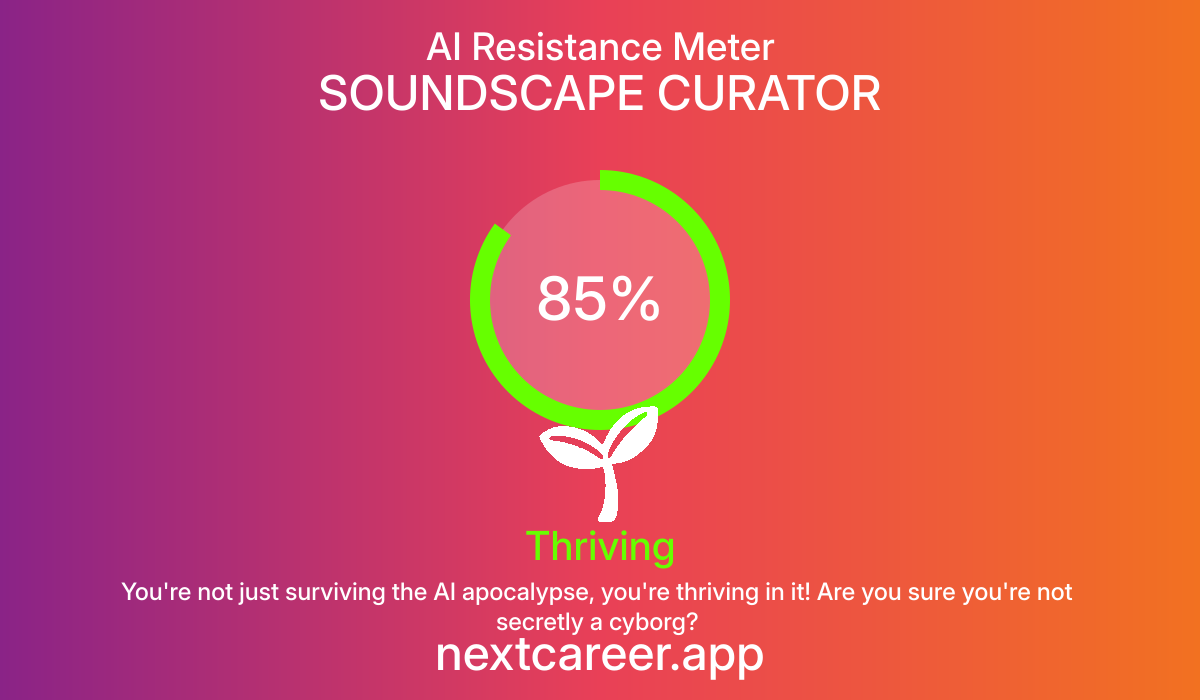AI Resistance Analysis
SOUNDSCAPE CURATOR
SOUNDSCAPE CURATOR
AI Resistance Score
AI Resistance Meter
Thriving
SOUNDSCAPE CURATOR
You're not just surviving the AI apocalypse, you're thriving in it! Are you sure you're not secretly a cyborg?
The role of a Soundscape Curator involves a deep understanding of sound ecology, creativity, and personal interpretation of auditory experiences. This position requires the application of subjective artistic judgment and a sensitivity to human emotions that current AI capabilities struggle to replicate. While AI can assist in generating sound pieces or analyzing sound data, the nuanced and interpretative role of a curator makes it resistant to full replacement. That said, AI can certainly augment this role, providing tools that enhance curation processes and sound analysis rather than replacing the curator altogether.
The role of a Soundscape Curator involves a deep understanding of sound ecology, creativity, and personal interpretation of auditory experiences. This position requires the application of subjective artistic judgment and a sensitivity to human emotions that current AI capabilities struggle to replicate. While AI can assist in generating sound pieces or analyzing sound data, the nuanced and interpretative role of a curator makes it resistant to full replacement. That said, AI can certainly augment this role, providing tools that enhance curation processes and sound analysis rather than replacing the curator altogether.
Key Factors
- Cognitive Tasks: The job requires complex cognitive tasks such as analysis of sound interplay and thematic curation. While AI can assist in cataloging and organizing sounds, the curatorial decisions remain subjective and depend on human insights.
- Emotional Intelligence: Soundscapes often evoke emotions and require an understanding of audience engagement. Curators can connect with the audience's feelings in a way AI currently cannot.
- Physical Skills: While physical tasks might involve equipment handling and installation, these can be augmented with technology without replacing the role.
- Creative Thinking: Creativity is central to the role. Soundscape Curators bring unique perspectives and innovation to their work, which AI can support but cannot fully generate at the human level.
Human Advantages
- Human curators can interpret and connect sounds to cultural, social, and emotional contexts effectively.
- Curators can drive artistic collaboration and community engagement, aspects crucial for soundscapes that AI cannot fulfill.
AI Vulnerabilities
- AI tools may automate data organization and preliminary sound analyses, reducing time spent on routine tasks.
- Emerging AI-driven sound generation could create passive soundscapes easily but lack the contextual understanding of artistic relevance.
Recommended Actions
- Invest in continuous learning about emerging AI tools in sound design to enhance curation methods.
- Embrace interdisciplinary approaches by collaborating with tech developers to create new sound experiences.
- Engage actively with community perspectives to ensure that soundscape curation resonates with audience values and cultural contexts.
In the near term (5 years), AI will likely serve as a collaborative tool for Soundscape Curators, aiding in sound collection and analysis. In the long term (20+ years), while AI may offer advanced suggestions and even generate soundscapes, the intrinsic human elements of curation—such as taste, emotional resonance, and unique creative vision—will keep the curator role relevant and vital. Additionally, societal values may lean towards authentic human experiences over AI-generated content, validating the importance of human curation.

Why Calculate AI Resistance?
Understanding how AI-resistant your career is becoming increasingly important in today's rapidly evolving job market. Our analysis combines multiple factors including required human skills, technological adaptability, and future industry projections to give you a comprehensive view of your career's sustainability.